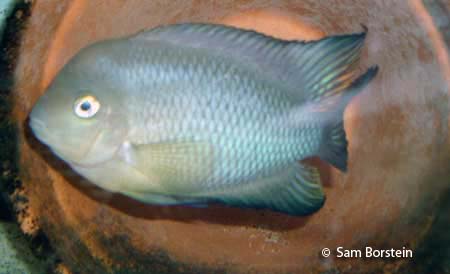Archocentrus spilurus
(Günther, 1862)
Blue Eyed Cichlid, Jade Eyed Cichlid
Synonyms: Cichlasoma spilurus, Cryptoheros spilurus

Above: A female Archocentrus spilurus. Photo by Sam Borstein.
Etymology:
Genus- Arch= anus (Greek), kentron= sting (Greek), Referring to the anal fin spines.
Species- spilo= spot (Greek), uros= tail (Greek). This refers to the spot in the tail of the fish, which is unique for the genus.
Intro:
The Blue Eyed cichlid is a fun Central to keep. Not attaining a large size, they are pugnacious like other members of this genus. This fish, first typed by Gunther in 1862, was originally found in Lago Izabel and was thought to have had a relatively wide distribution in the wild. According to Schmitter-Soto, The Blue eyed cichlid is restricted to Lago Izabel and its tributaries. What were thought to be the Northern and Southern color morphs of this species have been described as valid species, the northen being Cryptoheros chetumalensis (Schmitter-Soto, 2007) and the southern being Cryptoheros cutteri. This fish was made the type species of the new genus Cryptoheros by Allgayer in 2001. It is debated by some taxonomists if the genus Cryptoheros is valid or not. Because the description is done poorly, I don't view it as valid and therefore leave it in Archocentrus.
Distribution:
Archocentrus spilurus is restricted to Lago Izabel and its tributaries in Guatemala.
Size, Maturity, and Sexual Dimorphism:
Size: Males- 6 inches, Females- 4.5 inches
Maturity: 3 inches
Sexual Dimorphism: Males are larger than females, and attain trailers to the anal and dorsal fin. Males also possess a rounder head.

Above: A male Blue Eyed Cichlid. Photo by Sam Borstein.
Care:
Archocentrus spilurus is an easy fish to keep. They are aggressive and can dominate a tank, but can also be kept with a vast amount of other fish. I like keeping mine with larger Malawi Haps. The Haps know when they need to stay away and both fish tend to leave each other alone. They also mix well with milder Central Americans.
A problem that one encounters with this fish is the conspecific aggression. The fish can be rough on each other, but when a pair bond is formed, they are usually very strong.
Diet:
Archocentrus spilurus is an omnivore and will accept almost any food offered. A mix of flakes and pellets with a spirulina flake mixed in will keep the fish healthy.
Breeding:
The Blue Eyed Cichlid was easy to breed. The main trouble I encountered with this fish is the male wanting to spawn and the female not yet being ready to. The females take a while to get into breeding condition. The fish had their tubes down for about a week before they spawned.
Before spawning the pair darkens up considerably like many of the other Convict types. The pair usually defends the eggs with no problem. The fry, which can range in numbers from 100-500, are small and well defended. The fry are easily raised on baby brine shrimp.
Conclusion:
The Blue Eyed cichlid is a nice fish to keep. It doesn't have much color, but fills a tank up nicely. It is easy to breed and the fish are good parents. This fish can be hard to find at times but is kept in the hobby.
References:
- Allgayer, R. (2001) Description d'un genre nouveau, Cryptoheros, d'Amérique Centrale et d'une espèce nouvelle du Panama (Pisces: Cichlidae). L'An Cichlidé, 1, 13–20.
- Günther, A. (1862) Catalogue of the Fishes in the British Museum. Vol. IV. British Museum, London, 534 pp.
- Miller, R.R., Minckley, W.L. & Norris, S.M. (2005) Freshwater Fishes of México. Museum of Zoology, University of Michigan, & University of Chicago Press, Chicago, 652 pp.
- Schmitter-Soto, J.J., 2007. A Systematic Revision of the Genus Archocentrus (Perciformes:Cichlidae), with the Description of Two New Genera and Six New Species. Zootaxa 1603, 1-76.
